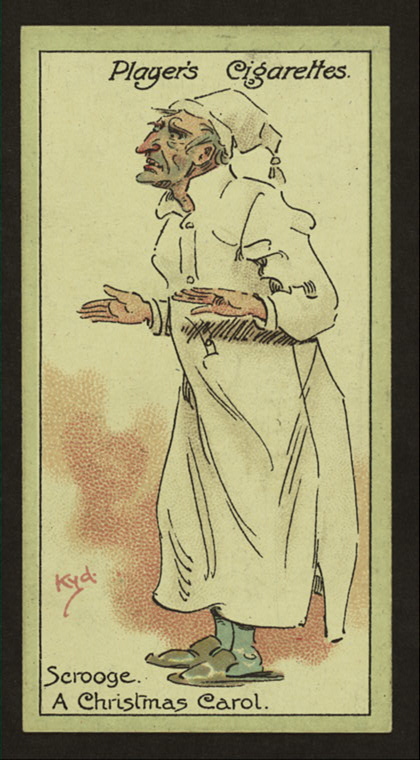The Creation of Christmas

"a good time: a kind, forgiving, charitable, pleasant time: the only time I know of in the long calendar of the year, when men and women seem by one consent to open their shut-up hearts freely, and to think of other people below them as if they really were fellow-passengers to the grave, and not another race of creatures bound on other journeys."
Yes, of course, that’s Scrooge’s nephew; but he and I seem to share the ideal of a benevolent, unhurried, and meditative Christmas in the midst of the contemporary tempest. What constitutes this traditional secular celebration? For me it is a cozy construct of movie images full of gently falling snow, music ranging from Bach’s Christmas cantatas to Jingle Bell Rock, some carefully sifted childhood memories, and of course, A Christmas Carol, the book that is probably Charles Dickens’s best-known and best-loved work, and the one which almost singlehandedly gave us the Christmas we know today.

By 1645, however, Oliver Cromwell and the Puritan forces detected a hot whiff of paganism in these rituals of the winter season and (Grinch-like) called an end to them. By the time Charles II was restored to the throne and the restrictions were rescinded, the traditions were largely forgotten and remained so for almost two hundred years. Even during the early part of the industrial Revolution, most people were too busy toiling and laboring to be bothered with a holiday which had fallen out of favor. Then, in the middle of the nineteenth century, Dickens wrote A Christmas Carol in a blaze of creative enthusiasm, and it became an immediate sensation. The warmth and charity of Dickens’s vision struck such a powerful chord in both England and the United States that everyone suddenly wanted to celebrate Christmas again in the old fashion.

British actor whose most famous
role was Ebenezer ScroogeThe first printing of A Christmas Carol was 6000 copies, and it sold out in a matter of days. Dickens had personally designed and edited the book; but in his desire to produce as handsome an artifact as possible he spared no expense, and his profit was consequently much smaller than expected. For me, one of the most exciting parts of my public presentation Out of the Blacking Factory: Charles Dickens at the New York Public Library was the opportunity, courtesy of the Rare Books Division, to display that 1843 edition, the one which Dickens himself saw into print. It is an exquisite little gem of a book, in a reddish binding stamped in gilt, and it fits comfortably in your hand. Several of the familiar John Leech illustrations, such as “Mr. Fezziwig’s Ball” and “The Second of the Three Spirits” are hand-colored and seem to glow with a luminescence that is never captured in any of the reprints or on the Internet. You can see the Rare Books Division's copy again during my final presentation on January 16th. In the meantime, another copy of the same work is on display as part of the Berg Collection’s Literary Christmas Miscellany exhibition through January 4th, located in Room 315.
Like many others, my first exposure to A Christmas Carol was watching the old British movie with Alastair Sim on television every year, an event I looked forward to almost as much as the annual The Wizard of Oz. Those stark black and white images stuck in my head, and led to the feeling (which lingers in some form to this day) that the dark hours between Christmas Eve and Christmas morning contained some sort of potent magic and that interesting events on a ghostly plane were a distinct possibility. Still, no matter how many of the endless dramatizations and adaptations you’ve seen--and what winter season would be complete without one or two--there is no experience comparable to actually reading A Christmas Carol.
I was in college when I discovered the book for the first time and recognized that what sets this work apart is Dickens’s unique voice. He is the narrator who, with the observation “Marley was as dead as a door-nail,” reflects that he himself might have regarded “a coffin-nail as the deadest piece of iron-mongery in the trade.”
When Scrooge discovers the knocker with Marley’s face, it is “not in impenetrable shadow, as the other objects in the yard were, but had a dismal light about it, like a bad lobster in a dark cellar.” And, after the night’s supernatural doings are over, he informs us that Scrooge “had no further intercourse with Spirits, but lived upon the Total-Abstinence Principle ever afterwards.”
These are just a few of the verbal niceties that could never be captured on film. I’ve read A Christmas Carol almost every year for half a lifetime now, and the liveliness and energy of Dickens’s words never fail to cast their Victorian magic spell. These days, just before Christmas, I read it out loud to my wife, one stave per night, a routine which has become an indispensible part of our personal holiday tradition.
Read E-Books with SimplyE
 With your library card, it's easier than ever to choose from more than 300,000 e-books on SimplyE, The New York Public Library's free e-reader app. Gain access to digital resources for all ages, including e-books, audiobooks, databases, and more.
With your library card, it's easier than ever to choose from more than 300,000 e-books on SimplyE, The New York Public Library's free e-reader app. Gain access to digital resources for all ages, including e-books, audiobooks, databases, and more.
If you don’t have an NYPL library card, New York State residents can apply for a digital card online or through SimplyE (available on the App Store or Google Play).
Need more help? Read our guide to using SimplyE.
Comments
Awesome folktale collection
Submitted by Anisul Hoque (not verified) on March 20, 2018 - 2:31pm